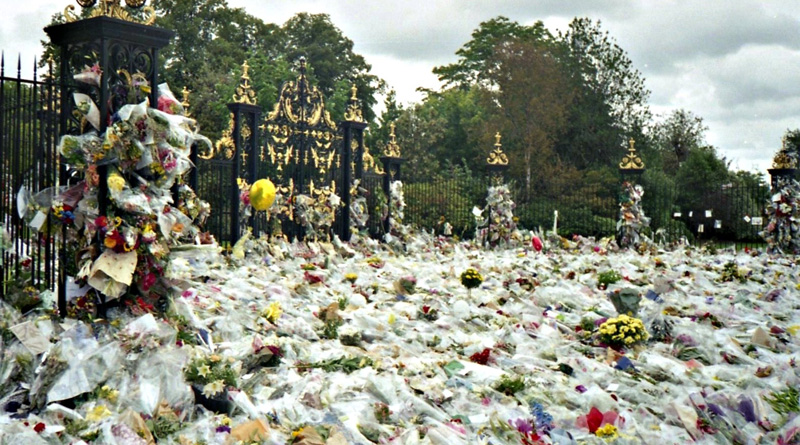A nation in mourning? The death of Diana and media coverage
It would be surprising if anyone reading this did not know that this coming Thursday, August 31st, is the 20th anniversary of the passing of Diana, Princess of Wales. Over the last month or so our television screens and newspapers have revisited her life and death in great detail. Sunday night’s BBC documentary Diana, 7 Days included interviews with Princes William and Harry who candidly described the events from the moment they heard news of the tragic accident to the day of their mother’s funeral.
Tuesday night saw ITV air the Kate Winslet narrated Diana: The Day Britain Cried which, according to the programme’s pre publicity, centred on a defining moment of our recent history when, “one million people lined the streets of London to witness the funeral procession, while 2.5 billion people around the world watched on television. And many openly wept.”
There is obviously still public appetite for Diana based stories. Indeed, earlier this month Channel 4’s controversial documentary Diana: In Her Own Words was the broadcaster’s most watched programme of the year and during the course of this week we can expect the national press to continue to focus on the “People’s Princess” and the impact her life and death has had on our national psyche.
But all this attention pales into insignificance when one considers the media coverage at the time of the death and funeral. According to media monitoring agency, Durrants Press Cuttings, the death of Diana was the subject of more newspaper coverage than the most dramatic events of WWII and the deaths of JFK and John Lennon. It’s staggering to think that in the four weeks following the tragedy 40% of all coverage in UK newspapers was Diana related.
On television news programmes Diana’s life was relentlessly examined and analysed. This was a life lived in the spotlight that was cinematic, dramatic and (in its finality) of divine proportions. As William Merrin pointed out, the repetition of familiar images accompanied by affecting music was the stuff of Hollywood.
Journalistic balance seemed to have been sacrificed, too – James Thomas was surely right when he wrote that being professional in media terms meant showing the audience that you were mourning and doing your job. On television and in the popular press there was virtually no space for those who wished to question the scale or tone of the coverage.
Merrin brilliantly describes the funeral itself in the manner of a sporting spectacle. It was, he writes, a media phenomenon watched by 31 million people in the UK that had a week long build replete with the road to Westminster Abbey replacing the road to Wembley stadium:
“Tuning in, in the morning, there was the same build-up, the same scene setting, the same review of the story so far, the same expectation, hype and punditry, the same talking heads, the same gloss and mise en scene, the same commentary, hyperbole, overstatement and forced melodrama, the same banalities, and the same clichés:”
But the death of Diana was not just a media phenomenon. Audiences the world over saw what was presented as some sort of pilgrimage as millions of people made their way to London in the week of the funeral to lay wreaths and show their condolences. This is important because the focus of the media’s attention became not only Diana but also the response of ‘the people’.
This abstract notion of ‘the people’ became part of the greater narrative as the media portrayed a nation gathered in mourning. On the eve of the funeral the BBC’s Jill Dando reported from the Mall on a “United Kingdom…united in grief”.
Glenda Cooper wrote in the Independent then of the Princess’ ability to appeal to disparate groups across the social divide. Everyone was eager to claim her as ‘one of us’ from criminals in Dartmoor grateful for her humanity to Susan Simmonds, who had travelled to Kensington from Swansea. Simmonds alluded to the fact that Diana was a daily presence in people’s lives. Ubiquitous, yet distant Simmonds spoke of a sort of one way intimacy:
“You lived her life because you saw so much of her – when she was emotional, when she was happy. You even ended up arguing over her but she was always there. I got married when she did, had my children about the same time. But I don’t think I really realised what she meant to us before.
The idea collective grief and of the “People’s Princess” has become central to the Diana story. It was Prime Minister Tony Blair, still riding the crest of election victory and high popularity, who gave currency to the phrase when he addressed the country on September 1st, 1997.
His first words assumed mass grief and communal shock -“I feel like the rest of the country today. Utterly devastated” – as he went on to say:
People everywhere, not just here in Britain, kept faith with Princess Diana.
“They liked her, they loved her, they regarded her as one of the people.
“She was the People’s Princess and that is how she will stay, how she will remain in our hearts and our memories for ever.”
The use of the word faith here is telling, because not only was Blair suggesting that the nation’s response to a personal tragedy should be that of collective mourning he was also elevating Diana to divine proportions – which is exactly what the media did in the week of the funeral. On September 1st 1997 the Daily Mirror proclaimed. “Born a Lady, Became a Princess, Died a Saint” whilst the Sun lamented the “woman of God” and “the nearest thing we’ll get to an angel on earth”.Certainly, this was an extraordinary time in recent British history, the like of which has not been seen since. But was there a nation truly united in grief? James Thomas convincingly argues that there were relatively few people behaving in the way the media suggested. He writes that the actions attributed to the masses were shared by at the very most 10% of the population.
This is no way meant to disparage those who demonstrated their sadness but there is a big difference between those genuinely mourning the loss of an individual and those taking part in, or observing, a media event for a variety of different reasons.
In the next few days then, as we are encouraged to revisit that remarkable week in 1997, its worth remembering that the responses of a highly visible, emotional minority amplified by the media did not necessarily reflect the national mood.
Image credit, “Flowers for Princess Diana’s Funeral” by Maxwell Hamilton is licensed under CC BY 2.0


